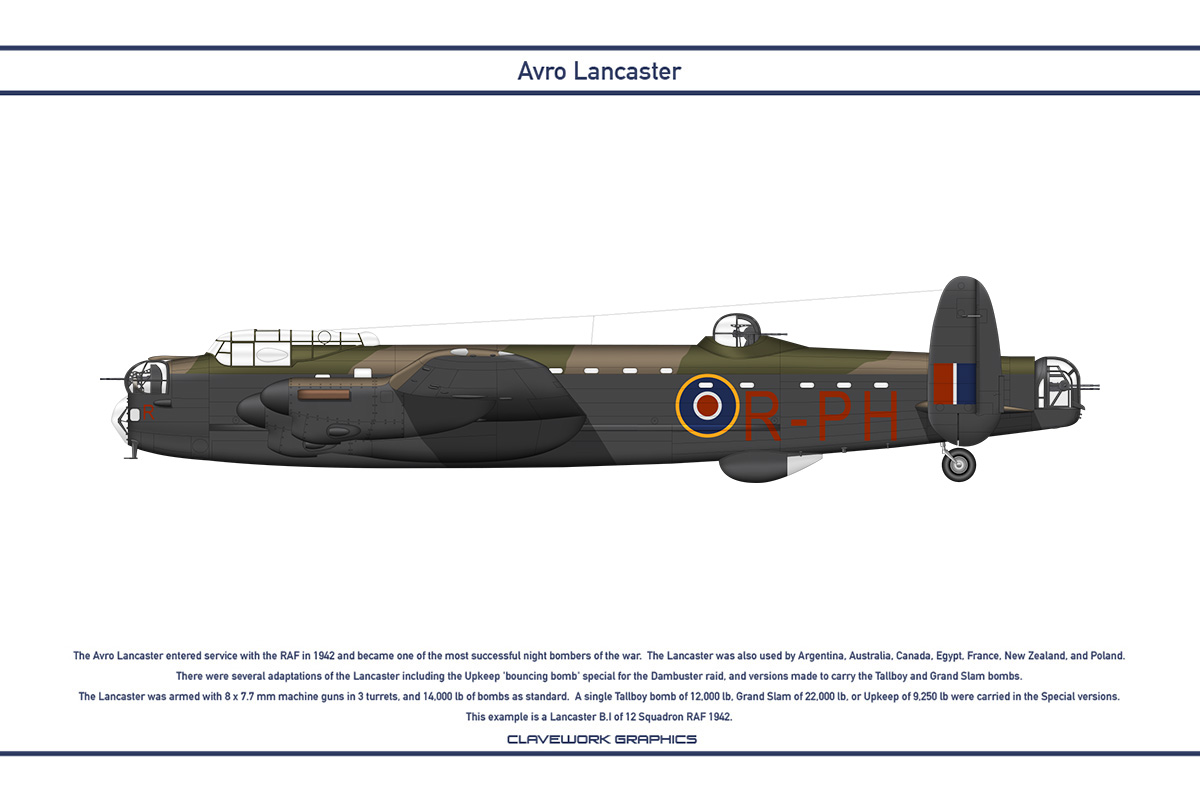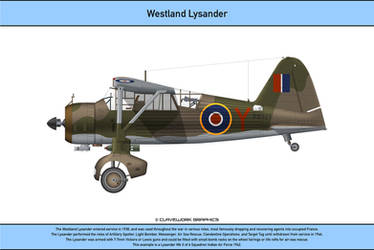ShopDreamUp AI ArtDreamUp
Deviation Actions
Description
The Avro Lancaster entered service with the RAF in 1942 and became one of the most successful night bombers of the war. The Lancaster was also used by Argentina, Australia, Canada, Egypt, France, New Zealand, and Poland.
There were several adaptations of the Lancaster including the Upkeep 'bouncing bomb' special for the Dambuster raid, and versions made to carry the Tallboy and Grand Slam bombs.
The Lancaster was armed with 8 x 7.7 mm machine guns in 3 turrets, and 14,000 lb of bombs as standard. A single Tallboy bomb of 12,000 lb, Grand Slam of 22,000 lb, or Upkeep of 9,250 lb were carried in the Special versions.
This example is a Lancaster BI of 12 Squadron RAF 1942.
There were several adaptations of the Lancaster including the Upkeep 'bouncing bomb' special for the Dambuster raid, and versions made to carry the Tallboy and Grand Slam bombs.
The Lancaster was armed with 8 x 7.7 mm machine guns in 3 turrets, and 14,000 lb of bombs as standard. A single Tallboy bomb of 12,000 lb, Grand Slam of 22,000 lb, or Upkeep of 9,250 lb were carried in the Special versions.
This example is a Lancaster BI of 12 Squadron RAF 1942.
Image size
1200x800px 131.55 KB
© 2010 - 2024 Claveworks
Comments32
Join the community to add your comment. Already a deviant? Log In
12 RFC Squadron, was formed at Netheravon, Wiltshire, on 4 February 1915, and went to France in September of that year equipped with BE2c's under the command of Major CLN Newall (who later was Chief of the Air Staff from 1937-40).
It was first employed directly under General Headquarters, but from February 1916, until the Armistice, was engaged mainly on what are nowadays termed army co-operation duties.
The BEs were replaced by RE8s in August 1917.
After the Armistice the squadron formed part of the Army of Occupation in Germany and remained in that country until July 1922, when it was disbanded at Bickendorf.
In April 1923, 12 RAF Squadron was re-formed at RAF Northolt as a bomber squadron equipped with DH9As.
In 1924 it received Fairey Fawns; and in 1926 Fairey Fox high-speed day bombers.
On a number of occasions during exercises 12's Foxes eluded the defending fighters and this led to the adoption of the words "Leads the field" as the squadron motto.
The highly-polished metal nose cowlings of the aircraft also gave the squadron its nickname, "Shiny Twelve".
In 1931 12 became one of the first squadrons to have Hawker Harts.
Four years later, after the Italians had invaded Abyssinia, it moved to Aden to reinforce the Middle East Command.
It returned home in 1936 and re-equipped with Hawker Hinds at RAF Andover.
Early in 1938 the squadron was re-equipped with Fairey Battles, the first of which arrived in February.
A move was made to Bicester at the beginning of May 1939, and there in the months which followed the squadron awaited the call to arms.
On 2 September 1939, its 16 Battles landed at Berry-au-Bac, France, as part of 76 RAF Wing of the Advanced Air Striking Force or AASF.
During the summer of 1940 A great honour came to the squadron.
Flying Officer DE Garland RAF, a pilot, and Sergeant T Gray RAF, his observer, were posthumously awarded the Victoria Cross - the first RAF VCs of the Second World War.
'Judy' Garland led a low-level attack on a metal bridge, then in German hands, at Veldwezelt, over the Albert Canal, on 12 May 1940.
The three Battles which took part in this operation were all shot down - but not before one of them (and available evidence points to the fact of it being Garland's aircraft) had shattered the western truss of the bridge with its bombs.
The squadron withdrew in mid-June 1940 to RAF Finningley, Yorkshire.
From there it moved to RAF Binbrook early in July and in August it began attacking shipping in the German-held Channel ports.
At RAF Binbrook in November 1940, 12 began to re-equip with Wellingtons and trained on them during the ensuing winter.
On 10/11 April 1941, They used them for the first time when a raid was made on Emden.
When the first 1OOO-bomber raid was launched on 30/31 May 1942, 12 sent 28 aircraft - the largest number so far operated at any one time by the squadron.
The target was Cologne and four of the squadron's aircraft failed to return.
During the winter of 1942/43 12 converted to Lancasters at RAF Wickenby and thereafter continued to play a prominent part in RAF Bomber Command's offensive until 25 April 1945. During the eleven months from May 1944 to April 1945, the squadron's Lancaster MK I ME758 "N-Nuts" flew 108 operational sorties and dropped more than a million pounds of bombs.
Bomber Command WWII Bases:
Bicester : May 1939-Sep 1939
Berry-au-Bac, France : Sep 1939-Dec 1939
Amifontaine, France : Dec 1939-May 1940
Echemines, France : May 1940-Jun 1940
Souge, France : Jun 1940
Finningley : Jun 1940-Jul 1940
Binbrook : Jul 1940-Aug 1940
Thorney Island : Aug 1940
Eastchurch : Aug 1940-Sep 1940
Binbrook : Sep 1940-Sep 1942
Wickenby : Sep 1942 onwards
Bomber Command WWII Aircraft:
Fairey Battle : Feb 1938-Nov 1940
Vickers Wellington MK II and MK III : Nov 1940 & Nov 1942
Avro Lancaster MK I and MK III : Nov 1942 onwards
Code Letters:
During the 1938 Munich crisis 12 Squadron was allotted the code letters "QE".
In WW2 the squadron's aircraft were coded "PH" whilst certain Lancasters carried "GZ"
First Operational Mission in WWII:
17th September 1939 :
Reconnaissance in area 5 miles behind Franco-German frontier by 3 Battles.
First Bombing Mission in WWII:
10th May 1940 :
4 Battles despatched to bomb a German troop column on road between Luxembourg and Junglister.
I aircraft forced-landed at Piennes on outward journey after being hit by enemy fire.
Other 3 aircraft attacked primary but 2 of them failed to return.
Last Operational Mission in WWII:
25th April 1945 :
16 Lancasters bombed Berchtesgaden.
Last Mission before VE Day:
7th May 1945 :
19 Lancasters dropped supplies to Dutch at Rotterdam
Operation Manna.
It was first employed directly under General Headquarters, but from February 1916, until the Armistice, was engaged mainly on what are nowadays termed army co-operation duties.
The BEs were replaced by RE8s in August 1917.
After the Armistice the squadron formed part of the Army of Occupation in Germany and remained in that country until July 1922, when it was disbanded at Bickendorf.
In April 1923, 12 RAF Squadron was re-formed at RAF Northolt as a bomber squadron equipped with DH9As.
In 1924 it received Fairey Fawns; and in 1926 Fairey Fox high-speed day bombers.
On a number of occasions during exercises 12's Foxes eluded the defending fighters and this led to the adoption of the words "Leads the field" as the squadron motto.
The highly-polished metal nose cowlings of the aircraft also gave the squadron its nickname, "Shiny Twelve".
In 1931 12 became one of the first squadrons to have Hawker Harts.
Four years later, after the Italians had invaded Abyssinia, it moved to Aden to reinforce the Middle East Command.
It returned home in 1936 and re-equipped with Hawker Hinds at RAF Andover.
Early in 1938 the squadron was re-equipped with Fairey Battles, the first of which arrived in February.
A move was made to Bicester at the beginning of May 1939, and there in the months which followed the squadron awaited the call to arms.
On 2 September 1939, its 16 Battles landed at Berry-au-Bac, France, as part of 76 RAF Wing of the Advanced Air Striking Force or AASF.
During the summer of 1940 A great honour came to the squadron.
Flying Officer DE Garland RAF, a pilot, and Sergeant T Gray RAF, his observer, were posthumously awarded the Victoria Cross - the first RAF VCs of the Second World War.
'Judy' Garland led a low-level attack on a metal bridge, then in German hands, at Veldwezelt, over the Albert Canal, on 12 May 1940.
The three Battles which took part in this operation were all shot down - but not before one of them (and available evidence points to the fact of it being Garland's aircraft) had shattered the western truss of the bridge with its bombs.
The squadron withdrew in mid-June 1940 to RAF Finningley, Yorkshire.
From there it moved to RAF Binbrook early in July and in August it began attacking shipping in the German-held Channel ports.
At RAF Binbrook in November 1940, 12 began to re-equip with Wellingtons and trained on them during the ensuing winter.
On 10/11 April 1941, They used them for the first time when a raid was made on Emden.
When the first 1OOO-bomber raid was launched on 30/31 May 1942, 12 sent 28 aircraft - the largest number so far operated at any one time by the squadron.
The target was Cologne and four of the squadron's aircraft failed to return.
During the winter of 1942/43 12 converted to Lancasters at RAF Wickenby and thereafter continued to play a prominent part in RAF Bomber Command's offensive until 25 April 1945. During the eleven months from May 1944 to April 1945, the squadron's Lancaster MK I ME758 "N-Nuts" flew 108 operational sorties and dropped more than a million pounds of bombs.
Bomber Command WWII Bases:
Bicester : May 1939-Sep 1939
Berry-au-Bac, France : Sep 1939-Dec 1939
Amifontaine, France : Dec 1939-May 1940
Echemines, France : May 1940-Jun 1940
Souge, France : Jun 1940
Finningley : Jun 1940-Jul 1940
Binbrook : Jul 1940-Aug 1940
Thorney Island : Aug 1940
Eastchurch : Aug 1940-Sep 1940
Binbrook : Sep 1940-Sep 1942
Wickenby : Sep 1942 onwards
Bomber Command WWII Aircraft:
Fairey Battle : Feb 1938-Nov 1940
Vickers Wellington MK II and MK III : Nov 1940 & Nov 1942
Avro Lancaster MK I and MK III : Nov 1942 onwards
Code Letters:
During the 1938 Munich crisis 12 Squadron was allotted the code letters "QE".
In WW2 the squadron's aircraft were coded "PH" whilst certain Lancasters carried "GZ"
First Operational Mission in WWII:
17th September 1939 :
Reconnaissance in area 5 miles behind Franco-German frontier by 3 Battles.
First Bombing Mission in WWII:
10th May 1940 :
4 Battles despatched to bomb a German troop column on road between Luxembourg and Junglister.
I aircraft forced-landed at Piennes on outward journey after being hit by enemy fire.
Other 3 aircraft attacked primary but 2 of them failed to return.
Last Operational Mission in WWII:
25th April 1945 :
16 Lancasters bombed Berchtesgaden.
Last Mission before VE Day:
7th May 1945 :
19 Lancasters dropped supplies to Dutch at Rotterdam
Operation Manna.































